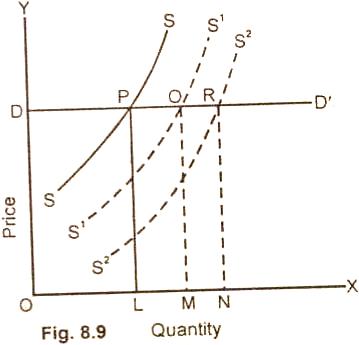Effects of Shifts in Supply on
Market Equilibrium:
Just as we
have discussed the
effects of changes in demand on price, we can also explain
the effects of changes in supply on the equilibrium price.
We assume
here that the demand curve remains fixed and a change takes place in the supply
of a commodity.
The change
in the supply of a commodity will result in shifting. Supply curve upward or
downward from the original supply curve. When supply rises, demand remaining the
same, the supply curve shifts downward from the original curve, i.e., it lies on
the right side of the original curve. In case of fall in supply, demand
remaining the same, the supply curve moves upward, i.e., it shifts to the left
side of the original curve. This can be also illustrated graphically.
Diagram/Figure:
.JPG)
In the
diagram (8.8) the demand curve DD/ is assumed as fixed and change
takes place only in the supply curve. SS/ shifts, to the right side
of the original curve, when supply rise. The S1S2 supply
curve was to the left side of the original supply curve when supply falls. PM is
the initial position of the equilibrium price and OM the initial equilibrium
amount. When supply increases, OK becomes the new equilibrium amount and NK the
new equilibrium price. When supply falls, OD
is the new equilibrium amount and FD the new equilibrium price.
Here again a
question can be asked that if supply rises, will it effect the quantity in
greater proportion or the price. The answer is that it depends upon elasticity
of demand. If demand is perfectly elastic, see in fig. (8.9) the price will not
be affected and quantity demanded will, however, increase with
the increase in supply. The price remains unaltered OD.

Inelastic Demand:
If the demand
is perfectly inelastic, then with a fall in supply, the quantity demanded will
remain unaffected and the price will go up.
With
inelastic demand curve, when supply decreases there is no change in the
quantity. It remains OM (figure 8.10). The price, on the other hand, rises from
ML to MK and then with further fall in supply, it increases to MZ. ln practice,
the elasticity of demand is neither perfectly elastic nor perfectly inelastic.
It is either equal to unity, greater than unity or less than unity.

If the
elasticity of demand is equal to unity, the quantity and price will be affected
in equal proportion with a rise or fall in supply.
If elasticity
is greater than unity, there will be greater change in quantity and less change
in price.
If elasticity
of demand is less than unity, then the price is affected more than the quantity
demanded.
Relevant Articles:
|